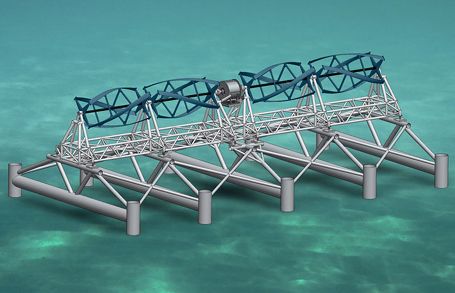The Reserve Bank has an interesting analysis of how crude oil is priced in world markets - The Pricing of Crude Oil.
Arguably no commodity is more important for the modern economy than oil. This is true in terms of both production and financial market activity. Yet its pricing is relatively complex. In part this reflects the fact that there are actually more than 300 types of crude oil, the characteristics of which can vary quite markedly. This article describes some of the key features of the oil market and then discusses the pricing of oil, highlighting the important role of the futures market. It also notes some related issues for the oil market. ...
The crude oil market is significantly larger than that for any other commodity, both in terms of physical production and financial market activity (Table 1).
The value of crude oil production is more than twice that of coal and natural gas, 10 times that of iron ore and almost 20 times that of copper. Crude oil is the most widely used source of fuel, supplying around one-third of the world’s energy needs. It is also used to produce a variety of other products including plastics, synthetic fibres and bitumen. Accordingly, changes in the price of crude oil have far-reaching effects.
The pricing mechanism underlying crude oil is, however, not as straightforward as it might appear. Almost all crude oil sold internationally is traded in the ‘over-the-counter’ (OTC) market, where the transaction details are not readily observable. Instead, private sector firms known as price reporting agencies (PRAs) play a central role in establishing and reporting the price of oil – the two most significant PRAs being Platts and Argus Media. ...
While physical crude oil can be purchased from
organised exchanges by entering into a futures
contract, only around 1 per cent of these contracts
are in fact settled in terms of the physical commodity.
Futures contracts are standardised contracts traded
on organised exchanges, specifying a set quantity
(usually 1 000 barrels) of a set type of crude oil for
future delivery. The two key oil futures contracts are
the New York Mercantile Exchange (NYMEX) WTI
light sweet crude and the Intercontinental Exchange
(ICE) Brent contracts. ...
With so many different grades of oil, there is actually
no specific individual market price for most crude
oils. Instead, prices are determined with reference
to a few benchmark oil prices, notably Brent and
West Texas Intermediate (WTI) (Graph 3). Brent
is produced in the North Sea and is used as a
reference price for roughly two-thirds of the global
physical trade in oil, although it only accounts for
around 1 per cent of world crude oil production
(Table 3). WTI is produced in the United States and
has traditionally dominated the futures market,
accounting for around two-thirds of futures trading
activity. However, futures market trading in Brent
has increased significantly in recent years to be now
close to that for WTI, reinforcing Brent’s role as the
key global benchmark (Graph 4). As discussed below,
Brent’s dominance as a benchmark has benefited
from the fact that it is a seaborne crude and, unlike
WTI (which is a landlocked pipeline crude), can
readily be shipped around the world.
These benchmarks form the basis for the pricing
of most contracts used to trade oil in the physical
(and financial futures) markets. For oil transactions
undertaken in the spot market, or negotiated via
term contracts between buyers and sellers, contracts
specify the pricing mechanism that will be used
to calculate the price of the shipment. So-called
‘formula’ pricing is the most common mechanism,
and it anchors the price of a contracted cargo to a
benchmark price, with various price differentials
then added or subtracted.
These price differentials relate to factors such as
the difference in quality between the contracted
and benchmark crude oils, transportation costs and
the difference in the refinery’s return from refining
the contracted and benchmark crudes into the
various petroleum products. For example, a barrel
of Brent is generally worth more than a barrel of
Dubai (a medium sour crude oil) because Brent will
yield more high-value gasoline, diesel and jet fuel
than Dubai without the need for intensive refining.
However, the actual magnitude of the Brent-Dubai
spread will depend on the relative prices of these
petroleum products at the time when the oil is sold to the refineries, along with the location and the spare
capacity in those refineries that can easily convert
lower-quality crude oil into higher-yielding petroleum
products. Reflecting changes in these fundamental
determinants, the Brent-Dubai spread has fluctuated
within a range of around US$0–15 per barrel.
These benchmark prices used in formula pricing are
usually based on either (i) ‘spot’ prices determined
by PRAs (for example, a ‘spot’ price published by
Platts called Dated Brent); or (ii) prices determined in
futures markets (for example, the assessed WTI price
published by the PRAs).
Oil companies often reference
more than one benchmark price depending on the
final destination; for example, Saudi Aramco typically
employs the Brent benchmark to price oil exports to
Europe, Dubai-Oman for exports to Asia and the Argus
Sour Crude Index for exports to the United States.
These particular crudes emerged as benchmarks due
to several distinctive characteristics. Brent developed
as a benchmark owing to favourable tax regulations
for oil producers in the United Kingdom, in addition
to the benefits of stable legal and political institutions
(Fattouh 2011). Ownership of Brent crude oil is well
diversified, with more than 15 different companies
producing it, which helps to reduce individual
producers’ pricing power.
Brent can also be used by
a variety of buyers, given that it is a light sweet crude
oil that requires relatively little processing.
The physical infrastructure underlying Brent is
also well developed. When the Brent benchmark
was established in the mid 1980s, its production
was initially reasonably large and stable, which is
an important characteristic of a benchmark as it
guarantees timely and reliable delivery. Although
the volume of Brent crude oil produced has declined
over time, three other North Sea crudes have been
added to the Brent benchmark basket over the
past decade, such that it now comprises Brent,
Forties, Oseberg and Ekofisk (BFOE; Graph 5). The
combination of these four alternatively deliverable
grades has allowed the Brent benchmark to retain a
reasonable volume of production. And while there
are concerns about the adequacy of production
volumes in the future, the depth and liquidity of
the Brent futures market has nevertheless increased
noticeably in recent years.
If alternative crude oils cannot be delivered against
a benchmark, declining production volumes can
weaken the status of that crude oil as a benchmark.
This is because it becomes a less accurate barometer
of current supply and demand as it becomes traded
less frequently, and lower traded volumes enable
individual market participants to influence the price
more easily. Malaysian Tapis – which was previously
a key benchmark for the Asia-Pacific region – is a
case in point. Tapis’s benchmark status has faded
away in recent years owing to declining production
volumes; recently, only a single cargo of Tapis has
typically been available for export each month,
down from around 8 cargoes per month in previous
years.
This compares with around 45 cargoes per
month currently for the Brent benchmark. Declining
production volumes, coupled with the absence of
any alternative similar crude oils produced in the
region, have seen refiners and producers shift to
benchmark against other prices, predominantly
Brent.
The emergence of WTI as a benchmark was also
assisted by the presence of secure legal and
regulatory regimes in the United States. WTI was
established as a benchmark in 1983 and its status
increased in prominence as the depth and liquidity
of its futures contract expanded. Like Brent, WTI is
a light sweet crude that is available from a broad
range of producers. Similarly, several different types
of crude can be delivered against the WTI contract,
including sweet crudes from Oklahoma, New Mexico
and Texas, as well as several foreign crude oils.
WTI crudes are delivered via an extensive pipeline
system (as well as by rail) to Cushing, Oklahoma.
Recently, however, the system has struggled to cope
with the increasing volumes of crude oil flowing
through Cushing. This has resulted in persistent
inventory bottlenecks, owing to Cushing’s limited
storage capacity and its landlocked location. These
bottlenecks have weighed on the WTI price in recent
years, to the point where it is now significantly
influenced by local supply and demand conditions,
in addition to those for the world as a whole (as
indicated by the divergence between WTI and Brent
oil prices shown in Graph 3). This has weakened WTI’s
status as a global benchmark. ...
Given that oil prices are essentially jointly determined
in both the physical and financial markets, it is no
easy task to disentangle the effect of each market
in the price discovery process with any precision.
Nevertheless, futures markets appear to play an
important role in the pricing of oil, perhaps more so
than for other commodities. Indeed, there is a view
that crude oil price levels are essentially determined
in the futures market.
This is clearest for WTI where PRAs identify the
‘physical’ price directly from the deep and liquid
futures market, and where there is no significant
parallel OTC market. It is less obvious, however, for
Brent. While Brent forward prices are typically used
by the PRAs to derive the Dated Brent price, as
noted above Brent forward and futures markets are
directly linked via EFPs. Many large oil market players
reportedly hold Brent forwards and futures in their
portfolios, arbitraging between the two instruments,
such that the prices of Brent futures and forwards
typically converge.
The complexity of the oil pricing arrangements
makes it difficult to demonstrate convincingly that
benchmark oil prices fully reflect physical supply
and demand conditions rather than the actions
of uninformed financial speculators. Nevertheless,
movements over time in the price differentials for
the various benchmark crudes are broadly consistent
with changes in demand and supply. The Brent-WTI
spread provides a good example of the influence of
such factors on oil price differentials (Graph 6). Prior
to 2011, Brent and WTI prices generally moved in
tandem, with the spread largely reflecting the costs of
transporting Brent-referenced crude oils to the United
States. In recent years, however, increased volumes of
crude oil from North Dakota and Canada have flowed
into Cushing, leading to a build-up in inventories.
Most pipelines flow from the rest of North America
into Cushing, making it difficult to move the extra
crude oil out of Cushing. This has led to persistent
inventory bottlenecks, which have weighed heavily
on the price of WTI over the past 18 months, leading
the Brent-WTI spread to widen to US$10–30 per
barrel.
The recent widening of the Brent-WTI spread
is also likely to reflect concerns about declining
production volumes in the North Sea.
More transparent information about oil reserves,
daily production volumes and demand-driven
factors could assist more efficient pricing in the
oil market. Information about the demand for oil
is often not known until well after the period for
which it is reported. On the supply side, there is
ongoing concern regarding the accuracy of various
countries’ reported production volumes, while oil
reserve estimates are subjective and depend on
partial information and project feasibility. There have
been steps towards greater transparency in the oil
market; for example, the Joint Organisations Data
Initiative (JODI) was established in 2001 to provide
accurate and timely crude oil data on production,
consumption, trade, refining and inventories.
Nonetheless, there is still scope to increase country
coverage and data quality



















